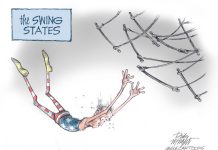This summer, I was on a quest to find Tecumseh’s final battle. I have been on other historical quests before. I have searched for the remains of the Polo Grounds, a historic baseball stadium in New York City. I have also retraced the footsteps of writer Dashiell Hammett in San Francisco.
In July, my wife and I drove out to Niagara Falls. On our way back, I wanted to find the site of Tecumseh’s death. American military forces, under the command of General William Henry Harrison, killed the American Indian leader at the Battle of the Thames during the War of 1812. William Jones, later a probate judge of Bartholomew County, fought in Harrison’s army. Unfortunately, the historical narrative has largely ignored the War of 1812.
I didn’t know what we would find at the battle site. I knew there was a historical marker along the road, but I do not know what force was calling me there. It might have been historical curiosity. But I think it was more than that. For some reason, it was one of the places on our trip to Ontario that I wanted to see the most.
Maybe I was looking for the real Tecumseh. His presence looms large over Indiana. He has become a legend. Most of what we are told about Tecumseh is from non-American Indian sources and scholars. His name is on several schools throughout the Midwest. Artists’ depictions of Tecumseh include a frieze in the U.S. Capitol, a bust at Annapolis and his image on the Tippecanoe County courthouse. But the artists did not know what he really looked like. We do not know the real Tecumseh. Maybe I was trying to get to know the person behind the legend.
I grew up just a stone’s throw from the Battle of Tippecanoe. Canada seemed such a faraway place from the banks of the Wabash River. How did Tecumseh end up there? Why was he caught in the middle of a war between the United States and the United Kingdom?
Google Maps let us down. It told us that the battle site was only a few miles off of Ontario Highway 402. In reality, it was more than 30 miles from the highway. I was not deterred. We drove on Longwoods Road, passing scenic farmland and small towns not unlike those in Indiana.
It was late in the afternoon when we found the battlefield. It was warm and slightly overcast as we walked through a light woods. The woods are surrounded by tall cornfields and a marsh.
We found the expected historical marker. On October 5, 1813, Indian warriors led by Tecumseh fought a delaying action as British soldiers retreated from Detroit. Tecumseh was killed during the fight. Historians do not know how Tecumseh died or the exact spot where he fell.
Tecumseh was fighting in a much larger, longer conflict than the War of 1812. He wanted to save his way of life and culture. He wanted to preserve the way that First Nation or American Indian people connected to the land.
When Tecumseh was a boy, Virginia militiamen killed his father during Lord Dunmore’s War in 1774. Tecumseh grew up during a time of conflict. American Indians were caught in the middle of the fighting between the British and the colonists during the American Revolution. Tecumseh grew frustrated with repeated violations of treaties.
In an 1810 meeting at Vincennes with Harrison, Tecumseh reportedly said, “No tribe has the right to sell, even to each other, much less to strangers…. Sell a country! Why not sell the air, the great sea, as well as the earth? Didn’t the Great Spirit make them all for the use of his children?” Tecumseh was trying to build an American Indian confederation that would resist further colonization. His death dealt a fatal blow to that effort.
Along with the natural beauty of the site, the battlefield has a sculpture, Wisdom, that honors the American Indian leader. Gordon Reeve designed the sculpture, which is a large metal, turtle-shaped object surrounded by 10 benches. The benches include reflections on Tecumseh and his crusade. You can learn more about it at aplaceofmanygrasses.com.
It was a beautiful, yet sad place. I am not sure that I know the real Tecumseh any better. But I have a better understanding of his struggle, which continues to this day.
Aaron Miller is one of The Republic’s community columnists and all opinions expressed are those of the writer. He has a doctorate in history and is an associate professor of history at Ivy Tech Community College — Columbus. Send comments to [email protected].




